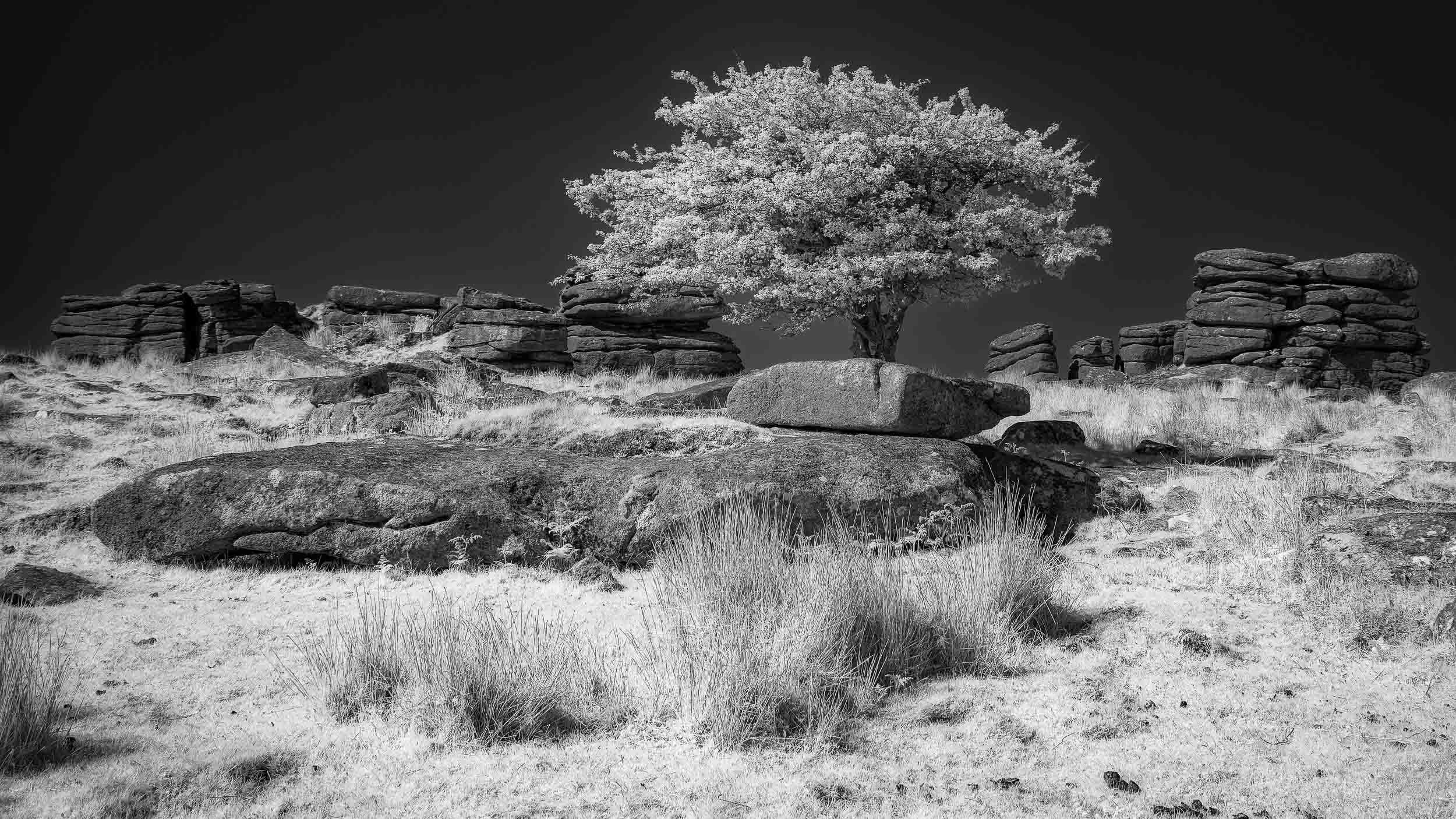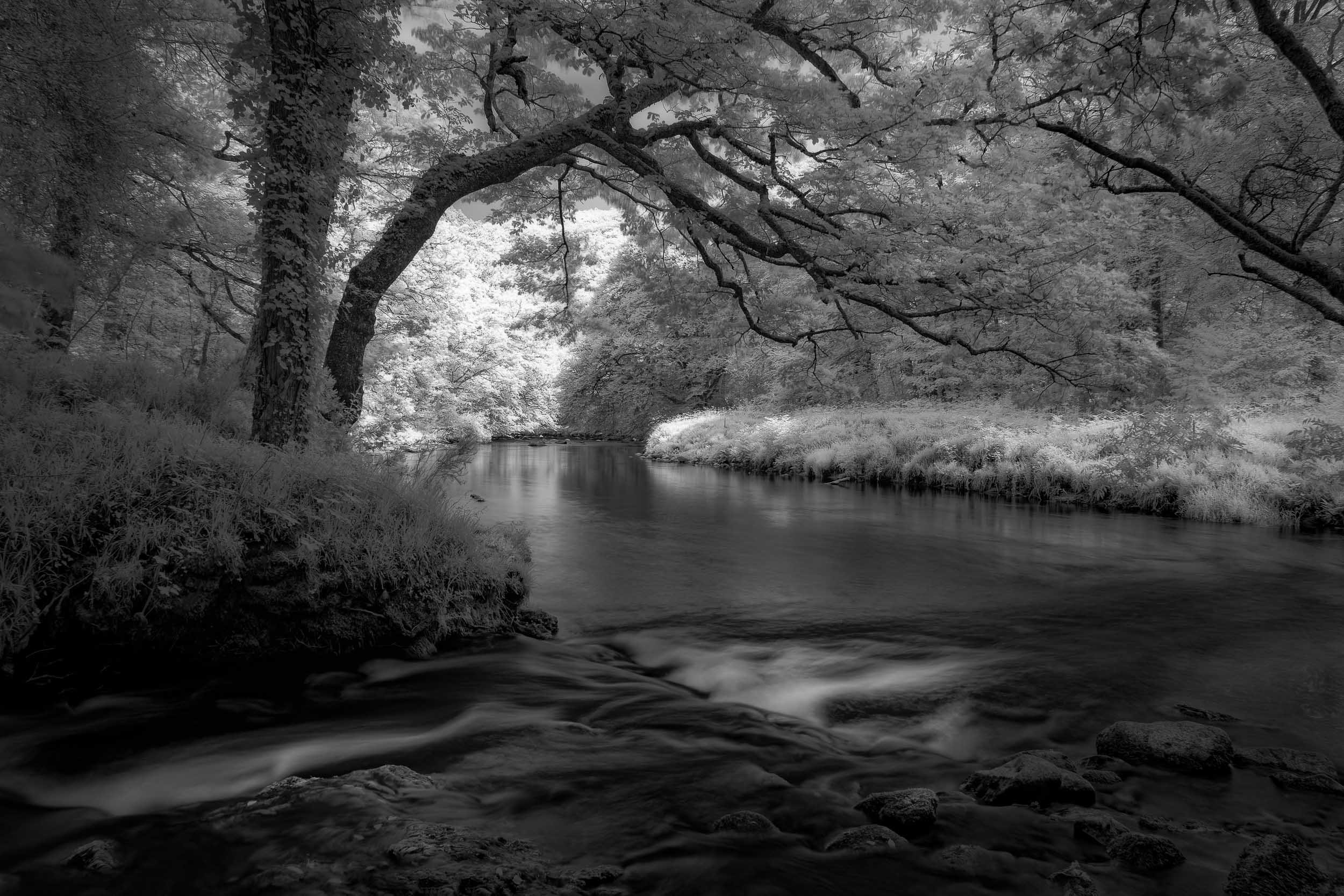May: month in review
Beyond visible light in Dartmoor and Hertfordshire…
Woodland Cottage, Ashridge Estate
Fujifilm X-T3 with 720nm IR conversion. Various settings.
What’s this month’s image? It’s a collage of infrared (IR) images taken on the Ashridge Estate, a National Trust property in Hertfordshire, on a morning spent with the very talented Simon Turnbull.
Did you do anything to it? I’ve touched on infrared photography previously, but the processing is typically quite straightforward if a little aggressive. The images come out of the camera with a distinct red hue but the files can be quite flat. While it’s perfectly possible to create false colour images, the high contrast black and white look is one that is commonly associated with infrared. Most of the techniques used for processing are common across ‘normal’ and IR photography, but with IR pushing quite hard on the dehaze slider in Lightroom works well, as does applying a blue filter in the black and white conversion.
Aside from that most of the slightly ethereal, other-worldly effect comes from the IR process itself. In particular, and especially in bright sunlight, foliage turns white. This is a consequence of the Wood Effect (named for Robert W. Wood rather than the wood itself which, in fact, presents as quite dark in IR photography). The impact can be emphasised by adding an Orton Effect to give the bright areas a little glow.
What’s it doing here? The month of May has been, in the vernacular, proper busy. For the first half of the month we were in Canada and Alaska, and I’ve written about that trip here. However, post-work planning is not proving to be a particularly strong suit and I’d somehow arranged a trip for the second half of the month to Dartmoor (see later) and Hertfordshire to spend a morning with Simon. Neither of these places are close to my house and, indeed, Dartmoor and Hertfordshire are really quite distant. I really must get into the habit of checking Google Maps before booking events!
The prompt for booking the Ashridge leg of the trip was a talk that Simon gave to the club on ‘intimate landscapes’. These are the small, intricate details in the landscape; the shapes, textures and colours that catch the eye. It’s also a genre that doesn’t demand you travel to find grand vistas and spectacular sunsets; it’s something that you can explore on your own doorstep. Although I went to Hertfordshire…
I’m glad that I did. Simon’s excellent company and a very good photographer. His approach is thoughtful - you might say mindful - and it was instructive to spend some time with him discussing how he approaches the genre. One of the points of conversation was the use of panels or collages as a presentational tool. Club photography, and club competition, is in the main focussed on the single image; thinking about the relationship between images is another dimension.
The type of photography that Simon practices often rewards looking at a scene from multiple angles and viewpoints; focusing on details rather than the whole. Individually, then, images can lack context; as a group of related images they become stronger, challenging the viewer to impute the whole from the sum of the parts. It’s an approach that appeals to me, but even at this stage it’s clear that to develop in this style will need time, patience and not a little discipline.
The other point that should be obvious is that not everything on the morning was shot in infrared. I’ve shown a colour example and a more conventional black and white panel below.
Have you been up to much else? It’s not been quiet. The reason that I even had the infrared camera with me for the morning with Simon was that I’d combined the trip with a couple of days shooting Dartmoor in infrared on a workshop organised by Lee Frost. I’ve talked about the value I get from workshops previously and this is the second trip I’ve done with Lee, after a very successful Cornwall trip last year.
Nuns Cross Farm
Fujifilm X-T3 with 720nm IR conversion | 18mm f/11 240s ISO 200
For somewhere like Dartmoor the local knowledge is really valuable and I’m more than happy that someone else was doing the driving on narrow roads with high hedges. Lee’s style, certainly on the two trips I’ve been on, is to get you to the location and let you get on with exploring the potential. Advice and suggestions are certainly on tap, but the trip is probably suited more to the experienced photographer.
We had a good group and most were, like myself, folk that had dabbled a little with infrared but were looking to devote a little more time to developing their understanding and skills. Dartmoor in the sunshine is certainly a brilliant place to explore the genre and Lee showed us a great variety of locations around the area. It was certainly interesting to explore an unfamiliar area with an infrared camera as the primary tool. Probably the biggest takeaway from the trip was that I should be a little braver in packing and using the IR camera. There’s a selection of the images and locations below, but the first one is probably worth commenting on.
We stayed at Northgate House Hotel, which is part of Buckfast Abbey. For those of us in the west of Scotland, the name Buckfast is most associated with the blight of the eponymous tonic wine, so I did have some misgivings. That said, the hotel was very good, the food excellent and the Abbey immaculate. It’s an excellent, if slightly odd , location if you need a base in the area.
In terms of the technical aspects of IR photography, a mirrorless camera conversion basically makes the composition and taking of images in the main as easy as with a conventional camera. (For owners of DSLR conversions the process is a little more clunky, but using live view gives a similar experience). There is also a fairly deep rabbit hole that you can down down on the technical side (types of conversion, processing, channel swapping, false colour to name but a few). I’m not wanting to do that here, but Adobe provide a good starter for ten here and YouTube will, of course, provide a range of tips, advice and tutorials, ranging from the invaluable to the worthless.
There are, however, a few of gotchas to watch out for at the capture stage if you’re shooting Raw.. Firstly, the camera’s metering system isn’t designed to work with infrared, so you’re probably better off working with the histogram rather than the meter reading. Typically most of the shots here were, according to the meter, at least a stop over-exposed.
However, there’s also a second gotcha. The first is that while it’s tempting to use a mono picture style or film simulation, this can really throw the histogram out. (In my camera it tends to suggest a scene is over-exposed and pushes you to reduce the exposure). You are much better using the flattest profile you can find and then using your standard expose to the right (ETTR) technique.
But… there’s a third gotcha which is that in the success of many images relies on capturing fine variation in the highlight tones. I ended up getting the greatest success by broadly exposing to the right, but ensuring that there was some small gap on the right hand side of the histogram.
It’s not for everyone, but personally I enjoy the technical aspects of the genre as well as the high impact black and white images that you can create. I thoroughly enjoyed the experience and have come back with a determination to pack the IR body a little more often.
Coming Up
Thankfully June is looking a little quieter. It’s the BSB meet at Knockhill, so will inevitably feature some motorbikes going quite quickly…










